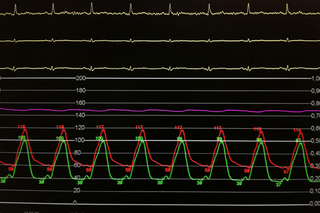Intracoronary pressure measurements
Intracoronary pressure measurements, which measure the blood pressure inside the coronary arteries, are used as part of a thorough assessment of coronary stenoses. Results from this test can provide a clear indication as to whether the reduction in blood flow at the site of stenosis is sufficiently severe to warrant an intervention.
What are intracoronary pressure measurements?
The term "intracoronary pressure measurement" refers to a procedure that directly measures the blood pressure inside the coronary arteries in order to determine the extent to which a stenosis affects blood flow through the affected vessel.
What happens during this procedure?
This procedure is pain-free, takes only a few minutes, and can be performed while the patient is undergoing cardiac catheterization. The procedure involves a special type of fine wire with a microscopic sensor attached to its tip being introduced into the coronary artery, where the sensor then obtains blood pressure measurements. Results from this procedure allow the physician to determine with certainty whether the narrowed coronary artery is still able to supply the heart muscle with a sufficient amount of oxygen, and whether symptoms such as angina pectoris (chest pain) occur as a direct result of the stenosis or not.
When is the use of intracoronary pressure measurements advised?
In certain cases, it may be impossible to accurately assess the degree of coronary artery stenosis present - even following extensive testing involving cardiac catheterization with x-ray imaging, and after taking into consideration previous examinations using ECGs, stress ECGs, stress echocardiography or myocardial scintigraphy. In these cases, intracoronary pressure can be determined through direct measurements.
Due to the fact that results are immediately available, this procedure ensures that where immediate treatment is essential this is not subject to delays. For instance, should a patient require balloon angioplasty or stent implantation in order to treat a stenosis, this can be done immediately, as part of the same procedure, and avoids the need for recatheterization. Finally, once the stenosis has been treated using balloon angioplasty and/or stent implantation, intracoronary pressure readings can be taken in order to to determine whether treatment has been successful.






